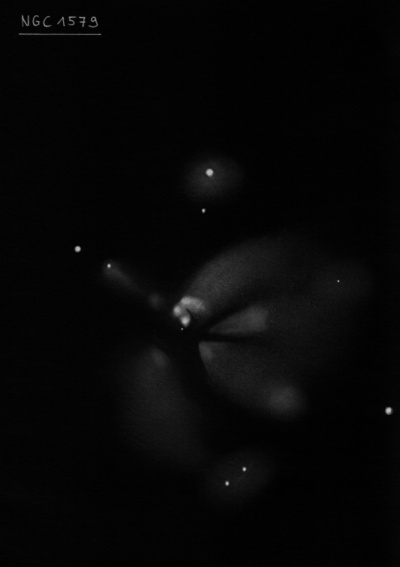
William Herschel discovered NGC 1579 = H I-217 = h315 on 27 Dec 1788 (sweep 899) and reported "pB, cL, mbM. Cometic. Stands nearly in the centre of a trapezium, 2 nf small stars pointing to it." John Herschel made three observations; in Nov 1827 (sweep 105) recording "pB; vL; irr R; it is inclosed among 6 stars, two of which point across its centre to a third. A * 7m precedes about 1 minute."
Samuel Hunter made a detailed sketch with the 72" on 13 Jan 1858 (fig. 8, plate XXV in LdR's 1861 publication). On 2 Nov 1850 Bindon Stoney logged "A faint patchy neby. follows the chief portion and also to the south. The chief portion is irregular in figure and I had the impression of a dark space intervening between it and the faint nebulosity."
200/250mm - 8" (12/6/80): faint nebulosity, diffuse.
300/350mm - 13" (1/18/85): fairly bright, circular, fairly small, appears brightest at the following edge. Forms an equilateral triangle with two mag 11.5-12 stars off the north and NE edges both 2' from center.
400/500mm - 17.5" (3/2/02): this bright reflection nebula appears nearly 5' in diameter with a prominent, slightly elongated 1.5' central region. The haze is irregular extending outward from this knot with the borders seemingly marked by a half-dozen stars situated around the periphery including a mag 11 star 2' N, a wide pair of mag 11.5-12 stars 1.6' and 2.3' NE and a pair of mag 13 stars ~2.5' S. Nebulosity extends mostly west and southwest of the central mass with a very faint piece to the south.
Notes by Steve Gottlieb